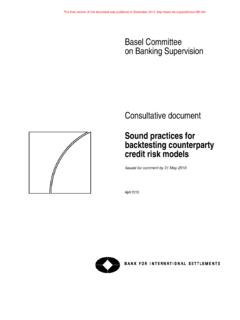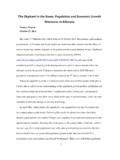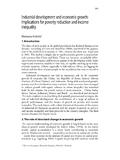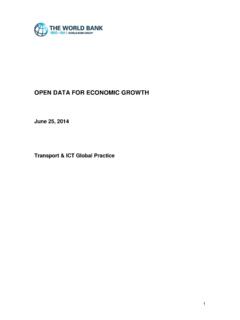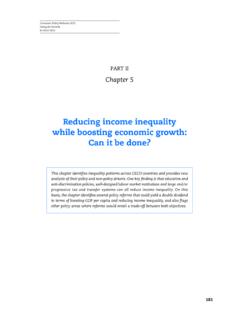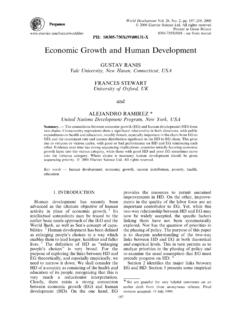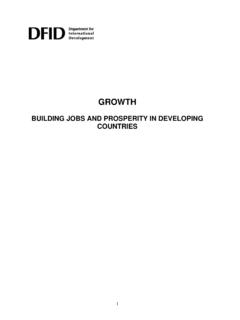Transcription of BIS Working Papers
1 BIS Working PapersNo 490 Why does financial sector growth crowd out real economic growth ? by Stephen G Cecchetti and Enisse Kharroubi Monetary and economic Department February 2015 JEL classification: D92, E22, E44, O4 Keywords: growth , financial development, credit booms, R&D intensity, financial dependence BIS Working Papers are written by members of the Monetary and economic Department of the Bank for International Settlements, and from time to time by other economists, and are published by the Bank. The Papers are on subjects of topical interest and are technical in character. The views expressed in them are those of their authors and not necessarily the views of the BIS.
2 This publication is available on the BIS website ( ). Bank for International Settlements 2015. All rights reserved. Brief excerpts may be reproduced or translated provided the source is stated. ISSN 1020-0959 (print) ISSN 1682-7678 (online) Financial sector growth and real growth 1 Why does financial sector growth crowd out real economic growth ? Stephen G Cecchetti and Enisse Kharroubi* September 2014 Abstract In this paper we examine the negative relationship between the rate of growth of the financial sector and the rate of growth of total factor productivity. We begin by showing that by disproportionately benefiting high collateral/low productivity projects, an exogenous increase in finance reduces total factor productivity growth .
3 Then, in a model with skilled workers and endogenous financial sector growth , we establish the possibility of multiple equilibria. In the equilibrium where skilled labour works in finance, the financial sector grows more quickly at the expense of the real economy. We go on to show that consistent with this theory, financial growth disproportionately harms financially dependent and R&D-intensive industries. Keywords: growth , financial development, credit booms, R&D intensity, financial dependence JEL classification: D92, E22, E44, O4 * Cecchetti is currently Professor of International Economics at Brandeis International Business School and former economic Adviser and Head of Monetary and economic Department at the Bank for International Settlements (BIS).
4 Kharroubi is Senior Economist at the BIS. This paper was prepared for the joint Institute for New economic Thinking-Federal Reserve Bank of San Francisco conference Finance and the Welfare of Nations, held in San Francisco on 27 September 2013. We thank Claudio Borio, Dietrich Domanski, Andy Filardo, Leonardo Gambacorta, Christian Upper and Fabrizio Zampolli for helpful discussions; and Garry Tang for valuable research assistance. The views expressed in this paper are those of the authors and not necessarily those of the BIS. Financial sector growth and real growth 2 1. Introduction In an earlier paper , we investigated how financial development affects aggregate productivity growth and concluded that the level of financial development is good only up to a point, after which it becomes a drag on growth , and that a fast-growing financial sector is detrimental to aggregate productivity growth (Cecchetti and Kharroubi 2012).
5 This second result is summarised in Graph 1, which plots the five-year average GDP-per-worker growth on the vertical axis and the five-year average growth in the financial sector s share in total employment on the horizontal axis (both as deviations from their country means). Graph 1 Financial sector growth and productivity growth1 1 Graphical representation of titiyttifdttiyi,,,5,,5, for a sample of countries over the period 1980 2009, where yi,t is the log of output per worker in country i in year t; yi,t+5,t is the average growth in output per worker in country ifrom time t to t+5; fdi,t+5,t is the average growth in financial intermediation employment share in country i from time t to t+5; i is a vector of country dummies; and i,t is a residual.
6 Country sample: Australia, Austria, Belgium, Canada, Denmark, Finland,France, Germany, Ireland, Italy, Japan, Korea, the Netherlands, New Zealand, Norway, Portugal, Spain, Sweden, Switzerland, the United Kingdom and the United States. Sources: Cecchetti and Kharroubi (2012), Graph 5. As we show in the earlier paper , the result that financial booms are a drag on growth is robust to the inclusion of a wide variety of conditioning Moreover, the effects are economically significant. For example, specifically, we establish that if, over the 2005 to 2009 period, Irish financial 1 This result holds in particular when the initial level of financial development financial sector size is controlled for.
7 This paper therefore stresses that the debate on finance and growth should move from the relationship between the level of finance development and growth (see Levine 1997, 2005 for detailed surveys) to the relationship between the growth of finance and economic growth . average real GDP-per-worker growthFive-year average financial intermediation employment growth (Deviation from country mean)(Deviation from country mean) Financial sector growth and real growth 3 sector employment had been flat rather than growing per year, it would have shaved percentage points off of the productivity decline. The purpose of this paper is to examine why financial sector growth harms real growth .
8 We begin by constructing a model in which financial and real growth interact, and then turn to empirical evidence. In our model, we first show how an exogenous increase in financial sector growth can reduce total factor productivity This is a consequence of the fact that financial sector growth benefits disproportionately high collateral/low productivity projects. This mechanism reflects the fact that periods of high financial sector growth often coincide with the strong development in sectors like construction, where returns on projects are relatively easy to pledge as collateral but productivity ( growth ) is relatively low. Next, we introduce skilled workers who can be hired either by financiers to improve their ability to lend, increasing financial sector growth , or by entrepreneurs to improve their returns (albeit at the cost of lower pledgeability).
9 3,4 We then show that when skilled workers work in one sector it generates a negative externality on the other sector. The externality works as follows: financiers who hire skilled workers can lend more to entrepreneurs than those who do not. With more abundant and cheaper funding, entrepreneurs have an incentive to invest in projects with higher pledgeability but lower productivity, reducing their demand for skilled labour. Conversely, entrepreneurs who hire skilled workers invest in high return/low pledgeability projects. As a result, financiers have no incentive to hire skilled workers because the benefit in terms of increased ability to lend is limited since entrepreneurs projects feature low This negative externality can lead to multiple equilibria.
10 In the equilibrium where financiers employ the skilled workers, so that the financial sector grows more rapidly, total factor productivity growth is lower than it would be had agents coordinated on the equilibrium where entrepreneurs attract the skilled Looking at welfare, we are able to show that, relative to the social optimum, financial booms in which skilled labour work for the financial sector, are sub-optimal when the bargaining power of financiers is sufficiently large. 2 Building on Pagano (1993), we model changes in financial sector growth as changes in financial transaction costs. 3 Goldin and Katz (2008) document the spectacular ascendancy of finance amongst (male) Harvard graduates in the 1990s and the 2000s.









